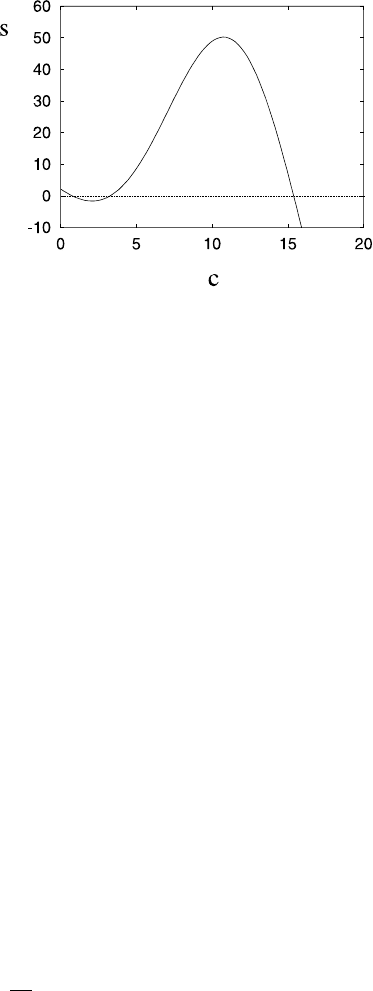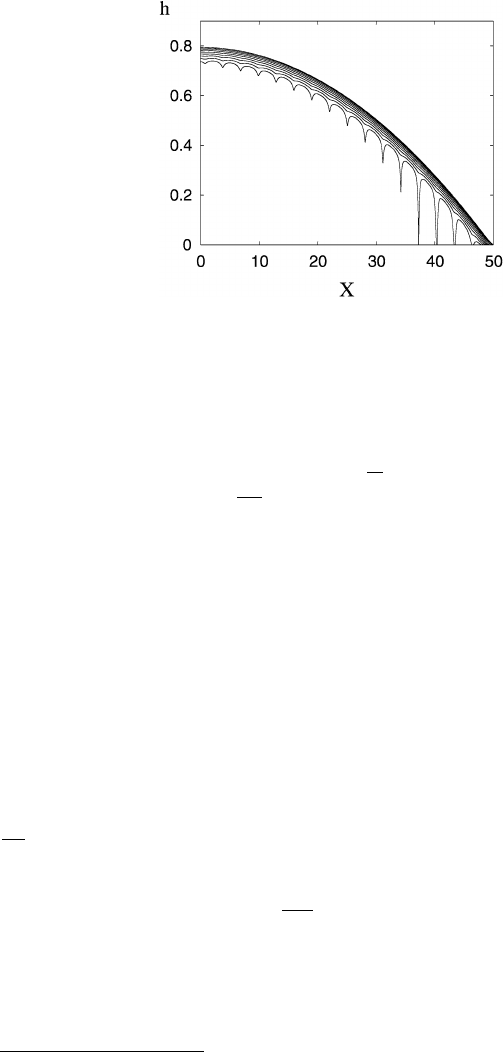Fowler A. Mathematical Geoscience
Подождите немного. Документ загружается.


710 10 Glaciers and Ice Sheets
The issue now arises, how to choose the scales l
i
and c
0
. To do this, we need some
understanding of how the model works, and for that, we need some idea of the size
of the parameters.
We take values I
0
=130 W m
−2
, a
0
=0.3, so that, with σ =5.67×10
−8
Wm
−2
K
−4
, we find T
0
= 200 K. We use values M
w
= 18 ×10
−3
kg mole
−1
, L = 2.8 ×
10
6
Jkg
−1
, R =8.3Jmole
−1
K
−1
, T
ref
=273 K, p
ref
s
=600 Pa, from which we find
p
0
s
≈0.18 Pa, and thus ρ
0
=2 ×10
−5
kg m
−3
.WetakeK
=2.2 ×10
−5
m
−1
sK,
whence we find m
0
≈2 ×10
−8
kg m
−2
s
−1
, and with ρ
i
∼0.9 ×10
3
kg m
−3
, s
0
≈
2.2 ×10
−11
ms
−1
.
We suppose that a katabatic wind of magnitude u
w
=10 m s
−1
exists in a layer of
depth H =100 m, so that we take q
0
=10
3
m
2
s
−1
. To estimate D
i
,weuse(10.418)
with n = 3 to motivate the choice D
i
≈
¯
Dh
7
0
, where
¯
D = 0.4A(ρ
i
g)
3
/l
2
i
, and we
use the observed value l
i
=500 km, and A =3 ×10
−27
Pa
−3
s
−1
, based on a basal
ice temperature of 220 K, itself based on a surface ice temperature of 200 K and an
areothermal heat flux of 20 mW m
−2
. Using the definitions of the depth scale, time
scale and diffusion coefficient, this leads to
h
0
=
s
0
l
2
i
¯
D
1/8
≈3,600 m, (10.436)
and then t
0
≈ 1.6 × 10
14
s ≈ 5 Ma and D
i
= 1.6 × 10
−3
m
2
s
−1
(corresponding
to an ice velocity of some 0.1my
−1
). We suppose that the depth scale over which
a surface dust layer occludes the ice reflectivity is F
0
= 1 cm, and we take the
turbulent diffusivity of the katabatic layer to be D
c
=D
ρ
=0.1u
w
H =0.1q
0
.
With all these values, we find
μ ≈0.3 ×10
−9
,D≈2 ×10
−5
,δ≈0.3 ×10
−5
,
β ≈30.4,ε≈0.6 ×10
−3
,γ≈0.5.
(10.437)
The values of σ , λ and ν depend on what we assume about erosion and settlement
of dust. We suppose that suspended dust grains have a diameter of the order of 1–2
microns. Then the Stokes settling velocity (5.8)is
v
s
=
ρgD
2
s
18η
≈10
−4
ms
−1
, (10.438)
assuming ρ = 2 ×10
3
kg m
−3
, g = 3.7ms
−2
, and the atmospheric viscosity is
η =10
−5
Pa s; we also suppose (see (5.7) and the line after (5.9)) that v
0
≈10
−2
v
s
.
If we define A =
c
0
ρ
s
, then we have
σ ≈0.5 ×10
7
A, ν ≈0.05,λ≈
10
−2
A
. (10.439)
The sizes (and signs) of the entrainment parameters R
c
and R
ρ
depend on what
we assume about the entrainment rates E
c
and E
ρ
. There is little to guide us in
this, except for the expectation that the numerators of R
c
and R
ρ
represent the total
entrained dust and vapour, while the denominators represent the magnitude of the
downslope fluxes; we thus expect numerators and denominators to be comparable,
and this suggests that in practice R
c
,R
ρ
O(1).

10.6 Glaciology on Mars 711
The issue of how we choose the precise values of l
i
and c
0
now arises. The
fact that numerically the parameter γ = O(1) is strongly suggestive of the idea
that we choose l
i
by requiring that γ = O(1), and without loss of generality we
may define γ =1. The choice of c
0
depends on how we imagine the dust behaves
at the ice surface. One possibility is that the dust-albedo feedback is engineered
through occasional atmospheric dust storms, which affects the temperature through
the dependence of Γ and α on c.Inthisview,F ≡ 0; the settlement velocity is
so small that no accretion can occur, and dust is incorporated in the surface via
snowfall, wherein ice accretes on dust nuclei. We then choose c
0
by requiring that
ν =σ, (10.440)
which is equivalent (with γ =1) to choosing
c
0
=r
si
ρ
0
, (10.441)
where r
si
is given by (10.427). It then follows from (10.428) that, dimensionlessly,
φ =
c
c +ρ
,s<0, (10.442)
and in fact we will assume that (10.442) applies also for s>0.
The equations for c and ρ now take the form
μc
t
+(qc)
x
=R
c
+φs +Dc
xx
,
μρ
t
+(qρ)
x
=R
ρ
+(1 −φ)s +Dρ
xx
,
(10.443)
and can be combined if we suppose that μ, R
c
, R
ρ
and D are all small, and that q
is constant. With the definition of φ in (10.442), we then have
dc
dρ
=
φ
1 −φ
=
c
ρ
, (10.444)
whence c ∝ ρ, and thus φ is constant. With this assumption, we can eliminate ρ
from the definition of s, and the equation for c takes the form
μc
t
+(qc)
x
=R
c
+φs(T,c) +Dc
xx
, (10.445)
where s can be expressed as
s =
1
(1 −φ)T
exp
β
1 −
1
T
−
c
φ
. (10.446)
Because ε is small, we can take
T ≈IΓα. (10.447)
The dimensionless incident radiation depends weakly on slope, and can be taken to
be
I =I
0
(c)(1 −mh
x
), (10.448)
where m ≈ 0.02. The incident radiation may also depend on dustiness through the
cooling effect associated with increased reflectivity in a dusty atmosphere, hence the
decreasing function I
0
(c). In general, the scaled co-albedo α will be an increasing

712 10 Glaciers and Ice Sheets
Fig. 10.26 The sublimation
function s defined by
(10.446), where we take
T =(1−σc)(1−mh
x
)(1+gc),
and use values m =0.02,
−h
x
=1, g =0.05, β =30,
σ =0.023, φ =0.2
function of both φ and F ; here we take it to be constant, α =1. The feedback in this
version of the model thus operates through the dependence of the greenhouse factor
Γ on c: Γ is an increasing function of c. Because β in (10.446) is large, s is very
sensitive to c.
The ‘derivation’ of (10.445) is suggestive rather than rigorous, but will serve as
the basis of a model for trough formation. Whether the conclusions we draw will
extend to the full system, and indeed, whether the concept of dust suspension and
snowfall is correct at all: these are questions which await further study.
10.6.2 Multiple Steady States
The reduced model which we now consider is that for h and c described by (10.433)
1
and (10.445), with s and T defined by (10.446), (10.447) and (10.448). It is clear
from the definition of s in (10.446) that if T increases with c, then s can be non-
monotonic. In general, s may have three zeroes as a function of c, and if we allow
for the cooling effect of a dusty atmosphere at high dust concentrations, the highest
zero can be quite modest, as indicated in Fig. 10.26.
The non-monotonicity of s allows the possibility of multiple steady states. The
simplest way to see this is to consider (10.445) with q constant, and to ignore the
very small terms in μ and D (we will reconsider their importance subsequently).
With q constant, a summit condition for c must be prescribed at x = 0. If s(c) has
three zeroes as shown in Fig. 10.26, denoted c
1
, c
2
and c
3
, then for sufficiently
small R
c
, c will tend towards either the largest or smallest zero of R
c
+φs. For both
values, the value of s =−R
c
/φ is the same and the steady profile for h is a parabola,
h =
R
c
2φ
1 −x
2
, (10.449)
assuming boundary conditions
h
x
=0atx =0,h=0atx =1. (10.450)

10.6 Glaciology on Mars 713
The multiplicity above depends on the choice of summit dust concentration, and
this is somewhat artificial, as there is no physical reason to prescribe c at the summit.
In reality, the downslope katabatic wind must be zero at the summit, so that in
general q will depend on the slope −h
x
. The simplest assumption is to take
q =−h
x
, (10.451)
and in this case, the equation for c is degenerate. Satisfaction of (10.445) (with
μ =D =0) at x =0 requires c to satisfy
(φ +c)s(c) =−R
c
. (10.452)
Again, there can be three different values, and each of these leads to a genuinely
different solution for h and c. In particular, if we denote a zero of (10.452)asc
∗
,
then the steady state solution for h corresponding to c =c
∗
is
h =
R
c
2(φ +c
∗
)
1 −x
2
; (10.453)
in particular, when c
∗
is large, the ice cap is essentially removed.
The discussion above assumes s independent of slope, i.e., m = 0. Non-zero
values of m modify the discussion, but only quantitatively.
10.6.3 Trough Formation
The presence of multiple steady states suggests the possibility of hysteretic tran-
sitions between the lowest and highest values of c. We expect the middle steady
state to be unstable. Although the steady state solutions depend on x, and in par-
ticular, c = c(x) if m =0, we will continue to refer to the steady states in terms of
the (possibly three) solutions of (10.452)asc
∗
i
, i = 1, 2, 3, bearing in mind that the
space-dependent solutions for c are simply the continuation to m =0 of the constant
solutions.
Suppose now that incident radiation I increases so that c
∗
1
and c
∗
2
coalesce and
disappear; essentially the graph of s in Fig. 10.26 is pulled upwards. A pre-existing
ice cap with c = c
∗
1
will undergo a transition to c = c
∗
3
: the ice cap will disappear.
How does this happen? The slope dependence of T and thus s means that coales-
cence of the roots occurs first, locally, where the slope −h
x
is greatest, at the margin
of the ice cap. As I increases further, the point on the ice cap where coalescence oc-
curs moves progressively back towards the summit.
In order to describe the transition, we consider the system
h
t
=−s +h
xx
,
μc
t
−(h
x
c)
x
=R
c
+φs +Dc
xx
,
(10.454)
and to mimic the dependence of s on c and −h
x
, we choose
s =f(c)+I −mh
x
, (10.455)

714 10 Glaciers and Ice Sheets
with
f(c)= A(c −c
1
)(c −c
2
)
1 −
c
c
3
, (10.456)
where we expect c
1
, c
2
∼O(1), c
3
1, A 1. We define
c =c
3
C, f =Ac
2
3
g, s =Ac
2
3
S, t =
μ
Ac
3
τ,
x =x
B
(τ ) +
D
Ac
3
ξ, h =h
0
(x) +λ
∗
H,
(10.457)
where
λ
∗
=μ
√
ADc
3/2
3
, (10.458)
so that
g =
C −
c
1
c
3
C −
c
2
c
3
(1 −C) ≈C
2
(1 −C), (10.459)
S =g(C) +
I
Ac
2
3
−
mh
0
Ac
2
3
−μmH
ξ
, (10.460)
and if we define
˙x
B
=−
h
0
Ac
3
, (10.461)
then H and C satisfy
c
3
DAH
τ
+h
0
H
ξ
=−S +
h
0
Ac
2
3
+μ
Ac
3
D
H
ξξ
,
C
τ
=φS +
R
c
Ac
2
3
+
h
0
C
Ac
3
+C
ξξ
+Λ(H
ξ
C)
ξ
,
(10.462)
where
Λ =
λ
∗
D
=
μc
3/2
3
√
A
√
D
. (10.463)
Suppose firstly that Λ 1. In that case, C satisfies
C
τ
≈φg(C) +C
ξξ
. (10.464)
For small C, g ≈ C
2
, and an initial blow-up begins to occur, in which C tends to
infinity at finite time at one position. However, when C ∼ O(1), g ≈C
2
(1−C), and
C saturates at C =1 and two travelling waves propagate outwards from the initial
blow-up position.
The consequent perturbation to the depth is computed from (10.462)
1
.Ifweas-
sume
√
c
3
DA 1, μ
c
3
A
D
1, then H is approximately given by
H ≈
1
h
0
∞
ξ
Sdξ, (10.465)

10.6 Glaciology on Mars 715
and this describes the front of the trough.
31
As ξ →−∞, the depth of the trough is
H =
1
|h
0
|
∞
−∞
Sdξ. (10.466)
This is not a uniformly valid description of H , because we require H → 0asξ →
−∞. Behind the blow-up region for C, the diffusion term and time derivative of H
become significant. Essentially, the trough drawdown diffuses backwards. We can
recover this region by defining
ξ =μ
c
3
A
D
X, τ =μc
3
AT , (10.467)
and then
H
T
−|h
0
|H
X
=H
XX
+
μ
√
c
3
A
√
D
−S +
h
0
Ac
2
3
, (10.468)
with H =0onT =0,X<0 and as X →−∞, and H =−H at X = 0. At large
times, the solution of this is essentially
H ≈−
1
2
H erfc
−
X +|h
0
|T
2
√
T
, (10.469)
and one can show that this diffusive wave travels backwards relative to x
B
at the
same rate that x
B
travels forwards.
The consequence of all this is that local blow-up of c causes a trough to form and
deepen as the region of saturated dust spreads. The trough thus formed will have an
essentially stationary rear face of length O(μ), and a shallower front face of length
O(μ
c
3
D
) (and these slopes become less severe with time).
If we take μ =10
−10
, D =10
−6
, c
3
=10
4
, A =1, then Λ =0.1; uncertainty in
parameter values means that in practice values of Λ = O(1) are plausible. In this
case, we cannot neglect the extra term in (10.462)
2
. However, note that the diffusive
coefficient μ
Ac
3
D
=
Λ
c
3
in (10.462)
1
remains small. If in addition
√
c
3
DA 1,
then it is still the case that h
0
H
ξ
≈−g(C), so that the blow-up equation (10.464)is
simply modified to
C
τ
−
Λ
|h
0
|
Cg(C)
ξ
≈φg(C) +C
ξξ
, (10.470)
and the same blow-up and formation of travelling waves occurs, modified only by
the advective drift upstream.
If in addition
√
c
3
DA ∼O(1), then the time derivative term in (10.462)
1
comes
into play. By inspection, it seems that blow-up will still occur, and that there will be
travelling wave solutions also in this case (see Question 10.19).
31
We have applied the boundary condition that H →0asξ →∞, rather than H →0asξ →−∞;
why?

716 10 Glaciers and Ice Sheets
Fig. 10.27 A simulation of Eqs. (10.454), (10.455)and(10.456). The space variable has been
rescaled as x = X/L (largely for historical reasons, so that the trough spacing in X will be
O(1)), and the equations are then solved in the same form, but using rescaled variables T =L
2
t,
S = s/L
2
, and with modified parameters
¯
R = R
c
/L
2
,
¯
I = I/L
2
,
¯
A = A/L
2
, ¯m = m/L.The
parameter values used to obtain the sequence of profiles of h above (plotted at time inter-
vals in T of 0.2uptoamaximumof2.6) are then L = 50, ¯m = 0.14,
¯
R = 0.001, μ = 0.1,
D = 0.002,
¯
I = 0.24 + 0.02T , c
3
= 90,
¯
A = 1, φ = 0.2, time step T = 0.005 and space step
X = 0.002. The initial profile for h is h
0
=0.8(1 −
X
2
L
2
), and the initial concentration profile for
c is c
0
=1.5 −0.005X +0.02 sin(
2πX
3
)
10.6.4 Multiple Troughs
Our discussion shows that troughs can form through local blow-up of the dust con-
centration profile. In order to describe the Martian polar caps, we need this blow-up
to occur at many different places along the surface. The simplest way in which this
can occur is that as the insolation increment I increases to the point where the
steady states c
1
and c
2
coalesce, the resulting instability occurs at a non-zero wave
number.
A straightforward local instability analysis of (10.454) and (10.455) suggests that
normal modes proportional to exp(ikx +σt) have slow solutions (corresponding to
diffusive ice surface relaxation) Re σ ∼−k
2
, and rapid growth solutions Re σ ∼
φf
μ
, assuming μ and D are small. A next approximation is then (if the steady dust
concentration is c
0
)
Re σ ≈φf
+
μc
0
φ
−D
k
2
+···, (10.471)
so that we can expect growth of troughs if D is sufficiently small.
32
Figure 10.27 shows a simulation in which troughs grow from an initial state in
which a small superimposed sinusoidal variation of dust concentration is applied.
32
But not if μ<D, as we have suggested.
10.7 Notes and References 717
This figure is suggestive of the idea that the model has the ability to reproduce
features which resemble the Martian troughs, but it is by no means clear that the
simple theory suggested here is correct. Further discussion follows in the notes. In
the model, trough formation occurs as the initial stages of collapse of the polar ice
cap. Numerical outputs vary widely with parameter choices. In particular, it is com-
mon to find initial blow-up near the margin, leading to a large trough reminiscent of
the Chasma Borealis.
10.7 Notes and References
The best source for general information about glaciers and ice sheets is the book by
Paterson (1994). This famous book was first published in 1968, upgraded to a sec-
ond edition in 1981 (but in typescript), then to an apparently terminal third edition
(and in LaTeX) in 1994, and now miraculously to a fourth edition (Cuffey and Pater-
son 2010). Other books with a similar aim are those by Hooke (2005) and Van der
Veen (1999). Books which are more concerned with observations in the field and
geomorphic processes include those by Benn and Evans (1998) and Bennett and
Glasser (2010), while the books by Lliboutry (1987) and Hutter (1983) are much
more abstract. Lliboutry’s (1964, 1965) earlier voluminous work gives useful de-
scriptions of early work in the subject, particularly in the nineteenth century, but
was unfortunately never translated from the French. There is a good deal of histori-
cal and geographical material, but the theoretical parts are inevitably dated.
From its origins as a hobby for geographers and climbers, glaciology has come to
occupy centre stage in the modern preoccupation with climate, and there are many
popular books detailing some of the more recent discoveries. Amongst these are the
books by Imbrie and Imbrie (1979), Alley (2002) and Walker (2003): the first two
by scientists, the third by a journalist, all of them entertaining.
Scaling Apart from some of the work at the end of the nineteenth century, de-
tailed by Lliboutry (1965), the application of theoretical mechanics to problems in
glaciology really begins after the second world war with the work of Nye, Weertman
and Lliboutry. Egged on by the vituperative Lliboutry, the decades after the war saw
enormous advances in the theoretical understanding of glacier flow. Applied math-
ematical principles come late to the scene, so that even something as simple as
non-dimensionalisation does not happen till the mid-1970s. Possibly the first paper
to do this in a formal way was that by Grigoryan et al. (1976), a paper which is
not often cited because of its impenetrability, occluding the matter as it does with a
heavy shroud of curvilinear coordinates. The basic lubrication approximation which
describes glacier and ice sheet flow was introduced as the ‘shallow ice approxima-
tion’ in my thesis (Fowler 1979) and in print by Fowler and Larson (1978), and this
phrase is still widely used. Fowler and Larson dealt explicitly with valley glaciers,
but the same small aspect ratio approximation can be used for ice sheets (Morland
and Johnson 1980; Hutter 1983; Morland 1984; Hutter et al. 1986 and Fowler 1992a,

718 10 Glaciers and Ice Sheets
of whom we follow the latter) and ice shelves (Morland and Shoemaker 1982), al-
though in practice similar approximations had been introduced earlier (Nye 1959;
Weertman 1957b).
Waves on Glaciers Both surface and seasonal waves were well known in the
nineteenth century. An early discussion of surface waves is by Finsterwalder (1907),
while Deeley and Parr (1914) provide a discussion of seasonal waves. Between the
wars, glaciology enters its barren period, and the emergence from this is perhaps
seeded by Gerald Seligman’s foundation of the Glaciological Society (first British,
later International) in 1936, but it is only after the war that some of the earlier inves-
tigations are revived. Lliboutry, in particular, was a great advocate of the expertise
of the early glaciological researchers.
The modern theory of surface wave motion received its impulse from John Nye’s
stay at CalTech, where a youthful Gerry Whitham had recently developed the the-
ory of kinematic waves Lighthill and Whitham (1955a, 1955b). This theory was
adapted by Nye (1960, 1963) to the study of linear waves on glaciers; a nonlin-
ear analysis is given by Fowler and Larson (1980b). A parallel development was
reported by Weertman (1958). Nye’s theory, based on perturbations of a parallel-
sided slab, yields the unphysical singularity at the snout which was mentioned in
Sect. 10.4.1.
Apart from the early work by Deeley and Parr (1914), there has been relatively
little interest in seasonal waves. The main exception to this is the paper by Hodge
(1974). Hewitt and Fowler (2008) provide a mathematical model which can produce
certain of the observed features.
Wave ogives are lucidly discussed by Waddington (1986).
The Head and the Tail As mentioned earlier, wave theory for glaciers is con-
founded by both the head of the glacier and its snout. To my knowledge, no one
has paid any attention to the modelling issue with the upstream boundary condi-
tion, as discussed here in Question 10.11. The resolution of the description of the
bergschrund
33
is likely to involve steepening bed slopes, and longitudinal stresses
which reach the fracture strength of ice (around 2 bars).
The snout of a glacier is a good deal more accessible. Even so, little attention has
been paid to that either. Nye and Lliboutry had a little engagement
34
about this in the
1950s (Lliboutry 1956, 1958b;Nye1957, 1958), and Chap. 6 of my thesis (Fowler
1979) uses the method of strained coordinates to calculate the finite slope at the
front. This involves inclusion of the longitudinal stresses, in much the same way as
in Question 10.11. If these are ignored, then the solution of the isothermal equation
has infinite snout slope if it is stationary or advancing, much as for (10.117); see
also Question 10.12.
33
The crevasse which marks the head of the glacier, where the ice separates from the stagnant
apron of snow and ice above it.
34
Or perhaps a spat; Nye’s opening sentence in his 1958 note is the wonderful comment: “In so far
as Professor Lliboutry is trying to make the theory of glacier flow more realistic one can only wish
him well and hope that he is on the right track.”

10.7 Notes and References 719
Boulton and Hindmarsh’s (1987) seven data points of basal shear stress, effective
pressure and till strain rate were presumably gleaned from observations near the
glacier snout. The original data were never published, so that one can only guess
how the values of shear stress were computed. In the absence of a local analysis of
behaviour near the snout, such values are tantamount to guesswork.
Surges Surging glaciers are located in various places round the world, including
Alaska and Svalbard. Famously, there are no surging glaciers in the European Alps,
but it is thought that there used to be at least one, Vernagtferner, in the Austrian
Alps, which last surged in about 1900.
35
Early paintings, documented by Nicolussi
(1990) indicate surges occurring in about 1600 and 1680, to judge from the jagged
surface of the glacier in the images, and further surges occurred in 1772, 1844, and
the small, perhaps final one in 1898. Apart from the last of these, the ice advanced to
block the outlet stream from Hintereisferner, causing an ice-dammed lake to form,
which burst through the ice, sometimes more than once, sending a flood wave down
the valley to the village of Vent.
The surge on Variegated Glacier is discussed by Kamb et al. (1985), and theo-
retical descriptions are given by Kamb (1987) and Fowler (1987a). The present dis-
cussion is based on this latter paper, the mathematical details of which are worked
out in Fowler (1989). Observations of Trapridge Glacier are described by Clarke et
al. (1984) and Frappé-Sénéclauze and Clarke (2007). The issue of the Journal of
Geophysical Research in which Fowler’s (1987a) article appears is a collection of
articles on fast glacier flow, including both ice streams, surging glaciers, and tide-
water glaciers.
Streams, Shelves, Sheets The dynamics of ice streams are reviewed by Bentley
(1987), see also Engelhardt et al. (1990), while the theory of Hudson Strait mega-
surges is due to MacAyeal (1993). Heinrich events are discussed by Bond et al.
(1992), while the discussion here is based on a paper by Fowler and Johnson (1995).
The recent acceleration of Jakobshavn Isbrae in West Greenland is described by
Holland et al. (2008).
The discussion of approximate temperature profiles follows that in Fowler
(1992a); the profiles shown in Fig. 10.7 are reminiscent of those shown in Paterson’s
(1994) book, and are also similar to the computed profiles of Dahl-Jensen (1989).
The concept of thermally induced instability was enunciated by Robin (1955) and
takenupbyClarkeetal.(1977) and Yuen and Schubert (1979), but more or less
scotched by Fowler and Larson (1980a), at least in the context of two-dimensional
flows; see also Fowler et al. (2009). However, Hindmarsh (2009) has shown that
thermally induced instabilities do occur in three dimensions, and are capable of
forming ice stream-like features.
The basic approximation for the analysis of ice shelves was done by Weertman
(1957b). A general scaling analysis is given by Morland and Shoemaker (1982).
35
See http://www.lrz.de/~a2901ad/webserver/webdata/vernagt/vernagt_E.html.
